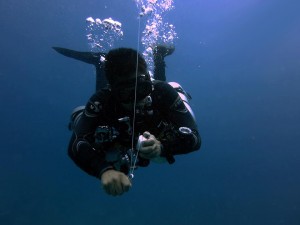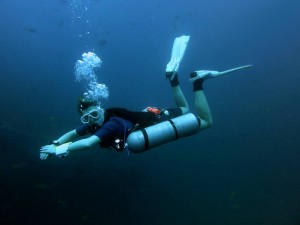Sidemount Diving
 There are many key benefits for both backmount and sidemount systems within the open circuit space however, many seasoned divers prefer one over the other. Depending on site makeup, situational requirements, and dive team goals, a diver skilled in both set ups has a clear advantage. That being said, sidemount is much less restricted to the technical realm in comparison to its twin set backmount counterpart. A diver with a beginner level of certification can jump into this increasingly popular configuration. So why do those who love sidemount favour this set up?
There are many key benefits for both backmount and sidemount systems within the open circuit space however, many seasoned divers prefer one over the other. Depending on site makeup, situational requirements, and dive team goals, a diver skilled in both set ups has a clear advantage. That being said, sidemount is much less restricted to the technical realm in comparison to its twin set backmount counterpart. A diver with a beginner level of certification can jump into this increasingly popular configuration. So why do those who love sidemount favour this set up?
Here are a few key advantages:
- Flexibility. As with any other diving system configuration, there are several options with sidemount. Generally speaking, most configurations provide the diver with enhanced flexibility in comparison to backmount. This is, after all, the driving force behind the development of sidemount. Generally weighing less and being easier to transport, sidemount was originally created to aid sump divers in the 1950s and 1960s. Needing a method to work their way through flooded passages but not adding to the weight carried for the journey, sump divers came up with the roots of sidemount. These systems have drastically improved since that time.
 Technical and Recreational Cave diving is the most prevalent and assumed benefit to sidemount configuration. From its early sump diving history to today’s more advanced cave penetration, cave divers are often faced with more remote and restrictive diving scenarios than in recreational or deep diving situations. Sidemount can be easily manoeuvred through tight restrictions along with providing the diver with the capacity of carrying multiple cylinders with a smaller overall diver physical profile. The positioning of backmount cylinders with or without decompression cylinders, may make it impossible to explore caves in the same way that a sidemount configuration may allow.
Technical and Recreational Cave diving is the most prevalent and assumed benefit to sidemount configuration. From its early sump diving history to today’s more advanced cave penetration, cave divers are often faced with more remote and restrictive diving scenarios than in recreational or deep diving situations. Sidemount can be easily manoeuvred through tight restrictions along with providing the diver with the capacity of carrying multiple cylinders with a smaller overall diver physical profile. The positioning of backmount cylinders with or without decompression cylinders, may make it impossible to explore caves in the same way that a sidemount configuration may allow.- In addition to technical cave and deep situations, recreational divers may too benefit from the additional gas contingency and comfort of the configuration. For newer divers, this configuration often requires early development in trim practice, gas management, and buoyancy control. Many divers who are beginning their journey into the professional space are looking for their next challenge. Sidemount is quickly becoming more and more popular across a wide span of divers.

- Career. Last but not least are the career advantages of becoming a sidemount instructor. Due to the variety of divers whose interests are peaked by sidemount configuration, there are obvious instructor career advantages. From giving yourself a competitive edge by addressing a more niche but growing market to improving your own diving skills, sidemount diving can greatly enhance our teaching arsenal. Ensuring that you become familiar with the multiple sidemount kits available, will drastically reduce the time required during initial configuration and will be key to successful conducting a course. In summary, whether the diver is an experienced cave diver who encounters tight restrictions or a recreational diver looking to improve their underwater safety and gas contingency, sidemount diving can address a wide gamut of diving variables.
